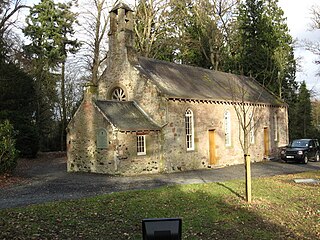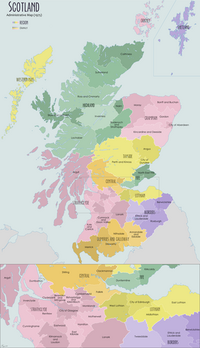
Midlothian is an historic county, registration county, lieutenancy area and one of 32 council areas of Scotland used for local government. Midlothian lies in the east-central Lowlands, bordering the City of Edinburgh council area, East Lothian and the Scottish Borders.

The Scottish Borders is one of 32 council areas of Scotland. It borders the City of Edinburgh council area, Dumfries and Galloway, East Lothian, Midlothian, South Lanarkshire, West Lothian and, to the south-west, south and east, the English unitary authorities of Cumberland and Northumberland. The administrative centre of the area is Newtown St Boswells.

Berwickshire is a historic county, registration county and lieutenancy area in south-eastern Scotland, on the English border. The county takes its name from Berwick-upon-Tweed, its original county town, which was part of Scotland at the time of the county's formation in the twelfth century, but became part of England in 1482 after several centuries of swapping back and forth between the two kingdoms. After the loss of Berwick, Duns and Greenlaw both served as county town at different periods.

Galashiels is a town in the Scottish Borders with a population of around 12,600. Its name is often colloquially shortened to "Gala". The town is a major commercial centre for the Borders region with extensive history in the textile industry. Galashiels is the location of Heriot-Watt University's School of Textiles and Design.

Peeblesshire, the County of Peebles or Tweeddale is a historic county of Scotland. Its county town is Peebles, and it borders Midlothian to the north, Selkirkshire to the east, Dumfriesshire to the south, and Lanarkshire to the west.

Roxburghshire or the County of Roxburgh is a historic county and registration county in the Southern Uplands of Scotland. It borders Dumfriesshire to the west, Selkirkshire and Midlothian to the northwest, and Berwickshire to the north. To the southwest it borders Cumberland and to the southeast Northumberland, both in England.

Selkirkshire or the County of Selkirk is a historic county and registration county of Scotland. It borders Peeblesshire to the west, Midlothian to the north, Roxburghshire to the east, and Dumfriesshire to the south. It derives its name from its county town, the royal burgh of Selkirk. The county was historically also known as Ettrick Forest.

Tweeddale is a committee area and lieutenancy area in the Scottish Borders council area in south-eastern Scotland. It had also been a province in the Middle Ages. From 1975 to 1996 it was a local government district. Its boundaries correspond to the historic county of Peeblesshire.

Roxburgh, Ettrick and Lauderdale is a lieutenancy area of Scotland. The lieutenancy area was created on 1 April 1996, when local government was reorganised across Scotland under the Local Government etc. (Scotland) Act 1994. The lieutenancy area covers the combined area of the two abolished local government districts of Roxburgh and Ettrick and Lauderdale, which had been nominally separate lieutenancy areas prior to 1996, although both lieutenancies were held by John Scott, 9th Duke of Buccleuch. The lieutenancy area broadly corresponds to the historic counties of Roxburghshire and Selkirkshire, plus small parts of Midlothian and Berwickshire.

Berwickshire, Roxburgh and Selkirk is a constituency of the British House of Commons, located in the south of Scotland within the Scottish Borders council area. It elects one Member of Parliament (MP) at least once every five years using the first-past-the-post system of voting.
Roxburgh, Selkirk and Peebles was a county constituency of the House of Commons of the Parliament of the United Kingdom (Westminster) from 1955 to 1983. It elected one Member of Parliament (MP) by the first past the post voting system.

Roxburgh and Berwickshire was a county constituency of the House of Commons of the Parliament of the United Kingdom (Westminster) from 1983 to 2005. It elected one Member of Parliament (MP) by the first past the post voting system.
This is a list of people who have served as Lord Lieutenant of Roxburgh, Ettrick and Lauderdale. This office replaced the Lord Lieutenant of Roxburghshire and the Lord Lieutenant of Selkirkshire in 1975.

Roxburgh and Berwickshire was a constituency of the Scottish Parliament until 2011. It elected one Member of the Scottish Parliament (MSP) by the plurality method of election. It was also one of nine constituencies in the South of Scotland electoral region, which elects seven additional members, in addition to nine constituency MSPs, to produce a form of proportional representation for the region as a whole.

Tweeddale, Ettrick and Lauderdale was a constituency of the Scottish Parliament (Holyrood). It elected one Member of the Scottish Parliament (MSP) by the plurality method of election. Also, however, it was one of nine constituencies in the South of Scotland electoral region, which elected seven additional members, in addition to nine constituency MSPs, to produce a form of proportional representation for the region as a whole.

Ettrick, Roxburgh and Berwickshire is a constituency of the Scottish Parliament (Holyrood) covering part of the council area of Scottish Borders. It elects one Member of the Scottish Parliament (MSP) by the plurality method of election. It is also one of nine constituencies in the South Scotland electoral region, which elects seven additional members, in addition to the nine constituency MSPs, to produce a form of proportional representation for the region as a whole.

Midlothian South, Tweeddale and Lauderdale is a constituency of the Scottish Parliament (Holyrood) covering parts of the council areas of Midlothian and Scottish Borders. Created for the 2011 election, it elects one Member of the Scottish Parliament (MSP) by the plurality method of election. It is one of nine constituencies in the South Scotland electoral region, which elects seven additional members, in addition to nine constituency MSPs, to produce a form of proportional representation for the region as a whole.

Mertoun is a parish in the south-west of the historic county of Berwickshire in the Scottish Borders area of Scotland. Together with the parish of Maxton, Roxburghshire it forms the Maxton and Mertoun Community Council area. It was included in the former Ettrick and Lauderdale District of Borders Region, by the Local Government (Scotland) Act 1973, from 1975 to 1996.

Galashiels Burgh Chambers is a municipal building in Albert Place, Galashiels, Scotland. The building, which was the headquarters of Galashiels Burgh Council, is a Category B listed building.

The Council Headquarters is a municipal building in Newtown St Boswells, in the Scottish Borders council area in Scotland. It serves as the headquarters of Scottish Borders Council.





















